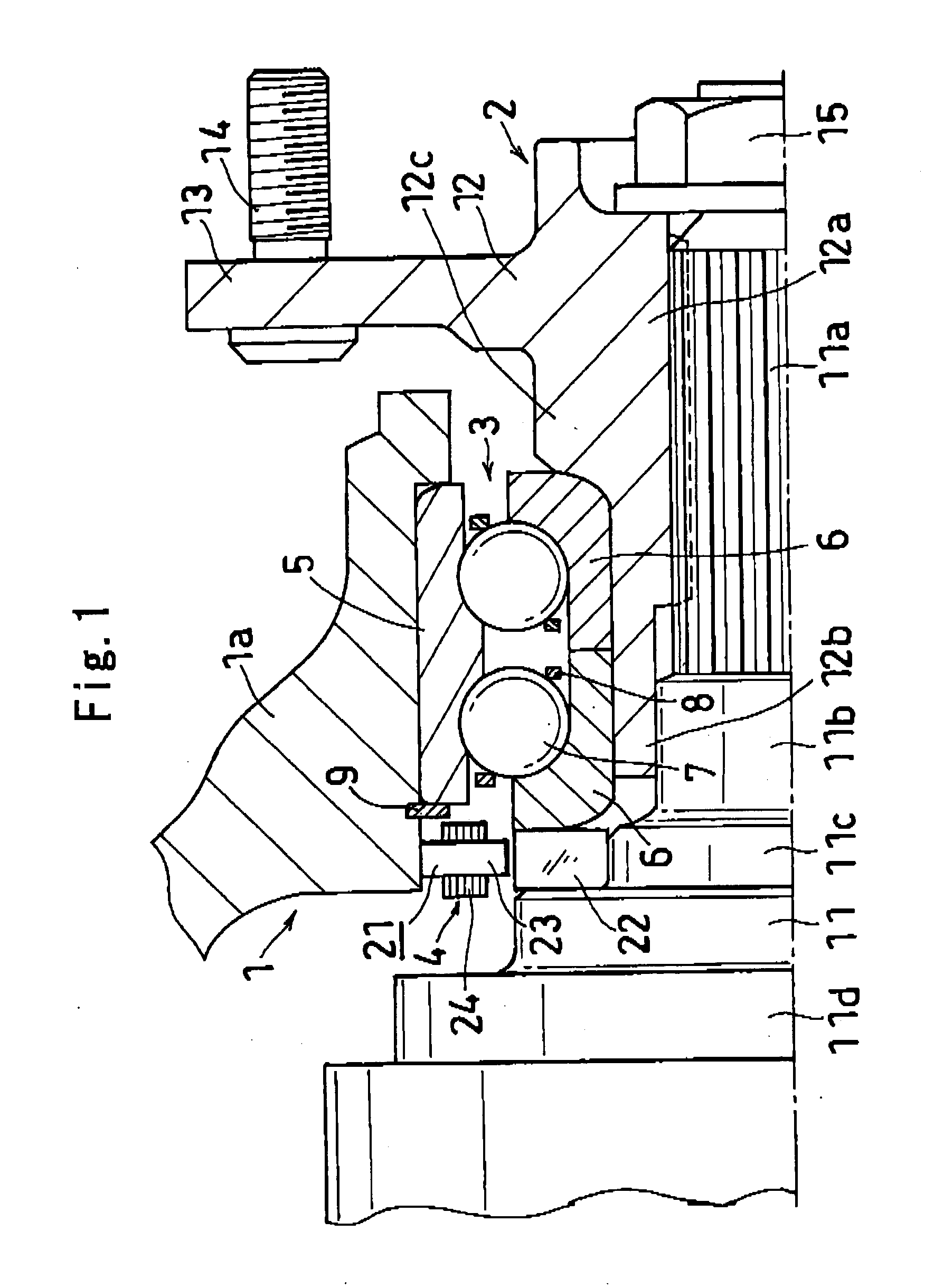Axle-supporting device
- Summary
- Abstract
- Description
- Claims
- Application Information
AI Technical Summary
Benefits of technology
Problems solved by technology
Method used
Image
Examples
first embodiment
[0065]FIG. 1 shows the axle support device of a first embodiment, which comprises a suspension member 1 to be attached to a vehicle body; an axle member 2 for a wheel to be mounted thereon; an antifriction bearing 3 having an outer ring 5 attached to the suspension member 1, inner rings 6 mounted on the axle member 2, a plurality of rolling bodies 7 arranged between the raceway rings 5, 6 and retainers 8 for holding these rolling bodies 7; and a sensor device 4.
[0066] The antifriction bearing 3, which is a double-row angular ball bearing, has balls serving as the rolling bodies 7 and arranged in left and right two rows between the outer ring 5 and the inner rings 6. The outer ring 5 is an integral ring having two raceways, while the inner rings 6 are divided rings each having a single raceway. The outer ring 5 is fitted in the inner periphery of a knuckle 1a constituting the suspension member 1 and fixedly held by a stepped portion provided in the vicinity of the right end thereof, ...
seventh embodiment
[0088] When the axle member 2 rotates in the axle support device of the seventh embodiment, the gap between the sensor face of the stator 21 and the outer periphery of the outer ring 17 of the universal joint 16 (the face of the rotor 33 to be detected) varies for the stator 21 to produce voltage in accordance with the angle of rotation. Variations in the voltage of the stator 21 are sent to a processing circuit via the signal line. Further when the ground contact load on the tire varies, the displacement of the axle member 2 varies relative to the suspension member 1. This alters the air gap between the stator 21 and the outer periphery of the outer ring 17 of the universal joint 16, as detected by the resolver. As shown in FIG. 23, the variations in the air gap are output from the resolver as voltage variations, while the processing circuit of the resolver (sensor device) has a rotation detecting unit. This unit determines the angle of rotation or rotational speed required, for ex...
eighth embodiment
[0092] The sensor device 4 of this embodiment has a VR-type brushless resolver comprising a stator 26 and a rotor 44 for measuring axial displacements. The stator 26 is provided around the right end portion (axial end toward the wheel) of the knuckle 1a of the suspension member 1 by a press fit, with its sensor face directed outward axially thereof. With respect to the radial direction, the stator 26 is located at the same position as the pitch circle of wheel attaching bolts 14 provided on the flange portion 13 of the hub shaft 12. As is the case with the eighth embodiment, the wheel attaching bolts 14 each have a top face serving as the face of the rotor 43 to be detected. Four to six wheel attaching bolts 14 are provided at equal intervals, so that the distance (gap) between the stator 26 and the top faces of the wheel attaching bolts 14 has four to six peaks every turn of rotation. Accordingly, the number of revolutions is detectable by counting up four to six peaks as one revol...
PUM
 Login to View More
Login to View More Abstract
Description
Claims
Application Information
 Login to View More
Login to View More - R&D
- Intellectual Property
- Life Sciences
- Materials
- Tech Scout
- Unparalleled Data Quality
- Higher Quality Content
- 60% Fewer Hallucinations
Browse by: Latest US Patents, China's latest patents, Technical Efficacy Thesaurus, Application Domain, Technology Topic, Popular Technical Reports.
© 2025 PatSnap. All rights reserved.Legal|Privacy policy|Modern Slavery Act Transparency Statement|Sitemap|About US| Contact US: help@patsnap.com



